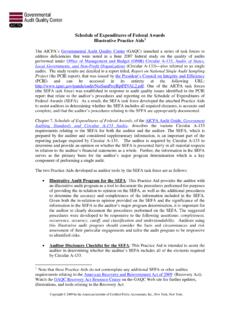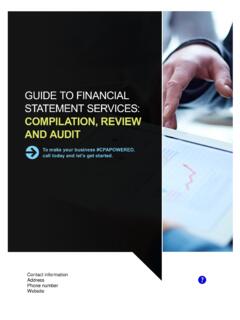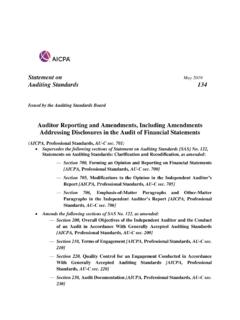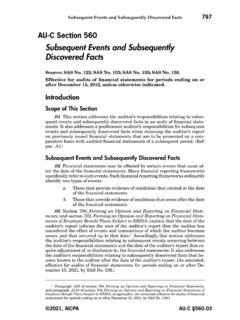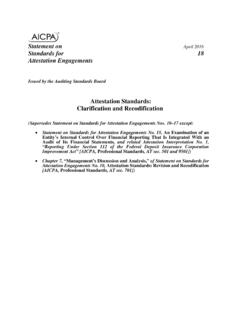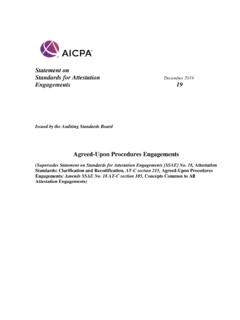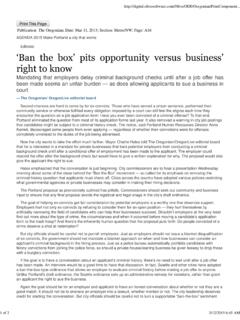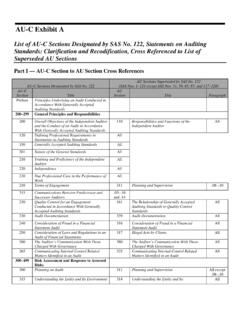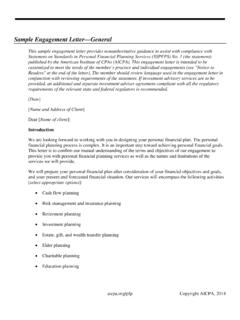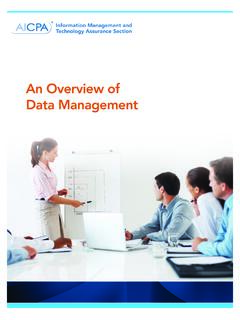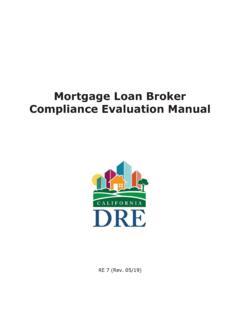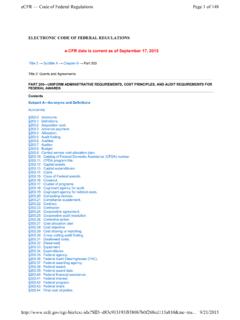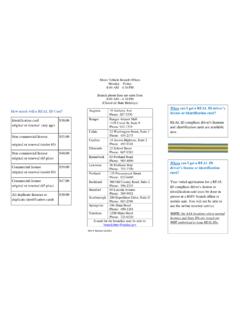Transcription of Treasury 2020 Compliance Supplement Addendum Final
1 December 2020 Coronavirus Relief Fund Treasury Compliance Supplement 2020 Addendum DEPARTMENT OF THE Treasury CFDA CORONAVIRUS RELIEF FUND I. PROGRAM OBJECTIVES The purpose of the Coronavirus Relief Fund (the Fund) is to provide direct payments to state, territorial, tribal, and certain eligible local governments to cover: 1. Necessary expenditures incurred due to the public health emergency with respect to Coronavirus Disease 2019 (COVID 19); 2. Costs that were not accounted for in the government s most recently approved budget as of March 27, 2020; and 3. Costs that were incurred during the period that begins on March 1, 2020, and ends on December 30, 2020, per section 601(d) of the Social Security Act, as added by section 5001 of the Coronavirus Aid, Relief, and Economic Security Act (CARES Act).
2 For more information on the limitation for use of payments from the Fund, please reference US Department of the Treasury s ( Treasury ) guidance located in the section below titled Availability of Other Program Information. Auditors should use Treasury s guidance and FAQs as the criteria when testing for the Fund, as well as when reporting findings. II. PROGRAM PROCEDURES A. Overview The Treasury provided assistance of $150 billion from the Fund in direct payments to state, territorial, tribal, and eligible local governments with $3 billion reserved for payments to the District of Columbia, Puerto Rico, US Virgin Islands, Guam, Northern Mariana Islands, and American Samoa and $8 billion reserved for payments to tribal governments. The remaining $139 billion were allocated for payments to the 50 states and eligible local governments with each state receiving a minimum payment no less than $ billion for fiscal year 2020.
3 Payments to states were subject to reduction based on payments to eligible local governments. Amounts paid to states and eligible local governments were based on 2019 population data from the US Census Bureau. Units of local government eligible for direct payment include counties, municipalities, towns, townships, villages, parishes, boroughs, or other units of general government below the state level with a population that exceeds 500,000. Eligible units of local government had to provide a certification to receive direct payment from the Fund. The secretary of the Treasury made a determination to allocate payments to tribal governments based on population, employment, and expenditure data. December 2020 Coronavirus Relief Fund Treasury Compliance Supplement 2020 Addendum State, territorial, tribal, and eligible local governments are required to use payments from the Fund to cover: 1.
4 Necessary expenditures incurred due to the public health emergency with respect to the Coronavirus Disease 2019 (COVID 19); 2. Costs that were not accounted for in the governments most recently approved budget as of March 27, 2020; and 3. Costs that were incurred during the period that begins on March 1, 2020 and ends on December 30, 2020 per section 601(d) of the Social Security Act, as added by section 5001 of the Coronavirus Aid, Relief, and Economic Security Act (CARES Act). Governments otherwise have broad discretion to utilize payments for expenditures ranging from COVID-19 testing including, but not limited to, reimbursing small businesses for the costs of business interruption caused by required closures. The CARES Act statutory criteria on use of payments from the Fund stated in section 601(d) of the Social Security Act, as added by section 5001 of the CARES Act and as interpreted in Treasury s guidance and FAQs, applies to prime recipients, subrecipients, and beneficiaries, as detailed in Section M.
5 On Subrecipient Monitoring below and Treasury s FAQ No. Please note that beneficiaries are not subject to audit per 2 CFR Part 200, Subpart F. B. Subprograms/Program Elements Not Applicable Source of Governing Requirements The Fund is authorized by the CARES Act, Pub. L. No. 116-136, Division A, Title V (2020) (codified as 42 USC 801 et seq.). Availability of Other Program Information Additional information on the Fund is available on the Treasury website at Treasury s guidance on the Fund can be found at: Treasury s FAQs can be found at: Treasury s Office of the Inspector General guidance on reporting and record retention can be found at December 2020 Coronavirus Relief Fund Treasury Compliance Supplement 2020 Addendum and Treasury s Office of the Inspector General Frequently Asked Questions (FAQs) can be found at If there are specific questions regarding the Fund, the CARES Program Office may be contacted via telephone at (202) 622-6415 or by e-mail at III.
6 Compliance REQUIREMENTS In developing the audit procedures to test Compliance with the requirements for this federal program, the auditor must determine, from the following summary (also included in Part 2, Matrix of Compliance Requirements ), which of the 12 types of Compliance requirements have been identified as subject to the audit (noted with a Y in the summary matrix below), and then determine which of the Compliance requirements that are subject to the audit are likely to have a direct and material effect on the federal program at the auditee. For each such Compliance requirement subject to the audit, the auditor must use Part 3 (which includes generic details about each Compliance requirement other than Special Tests and Provisions) and this program Supplement (which includes any program-specific requirements) to perform the audit.
7 When a Compliance requirement is shown in the summary below as N, it has been identified as not being subject to the audit. Auditors are not expected to test requirements that have been noted with an N. See the Safe Harbor Status discussion in Part 1 for additional information. A B C E F G H I J L M N Activities Allowed or Unallowed Allowable Costs/ cost Principles Cash Management Eligibility Equipment/ real Property Management Matching, Level of Effort, Earmarking Period Of Performance Procurement, Suspension & Debarment Program Income Reporting Subrecipient Monitoring Special Tests and Provisions Y Y N N N N Y N N Y Y N December 2020 Coronavirus Relief Fund Treasury Compliance Supplement 2020 Addendum A. Activities Allowed or Unallowed The Fund is designed to provide ready funding to address unforeseen financial needs and risks created by the COVID-19 public health emergency.
8 Governments may use Fund payments for eligible expenses subject to the restrictions set forth in section 601(d) of the Social Security Act. Payments must be used to cover costs that are: 1. Necessary expenditures incurred due to the public health emergency with respect to COVID 19; 2. Not accounted for in the governments most recently approved as of March 27, 2020; and 3. Incurred during the period that begins on March 1, 2020 and ends on December 30, 2020. A c ost meets the requirement of costs not accounted for in the budget most recently approved as of March 27, 2020 if either (a) the cost cannot lawfully be funded using a line item, allotment, or allocation within that budget or (b) the cost is for a substantially different use from any expected use of funds in such a line item, allotment, or allocation.
9 Please see Treasury s guidance on Costs not accounted for in the budget most recently approved as of March 27, 2020 at for additional details. Fund payments are not required to be used as the source of funding of last resort. However, recipients may not use payments from the Fund to cover expenditures for which they will receive reimbursement from other sources. Governments are responsible for making determinations as to what expenditures are necessary due to the public health emergency with respect to COVID-19. Please see Treasury s FAQs at , for more information related to the expenditures that may or may not be covered with payments from the Fund. B. Allowable cost / cost Principles As a direct payment for specified use, these funds are considered federal financial assistance, but not a grant.
10 In accordance with 2 CFR section (b) regarding applicability only certain provisions of the Code of Federal Regulations, Title 2, Subtitle A, Chapter II, Part 200 Uniform Administrative Requirements, cost Principles, and Audit Requirements for Federal Awards ( Uniform Guidance 2 CFR Part 200) apply to the Fund and these provisions include the following: a. Subpart A-Definitions; b. Subpart B-General provisions except for 2 CFR sections 113; December 2020 Coronavirus Relief Fund Treasury Compliance Supplement 2020 Addendum c. 2 CFR section regarding internal controls; d. 2 CFR sections 332 regarding subrecipient monitoring and management; and e. Subpart F Audit Requirements All other provisions of 2 CFR Part 200 are not applicable to the Fund. While 2 CFR Part 200, Subpart E, cost principles do not apply to the Fund, auditors should use Treasury s guidance and FAQs as the criteria when testing the allowability of costs under the Fund.
